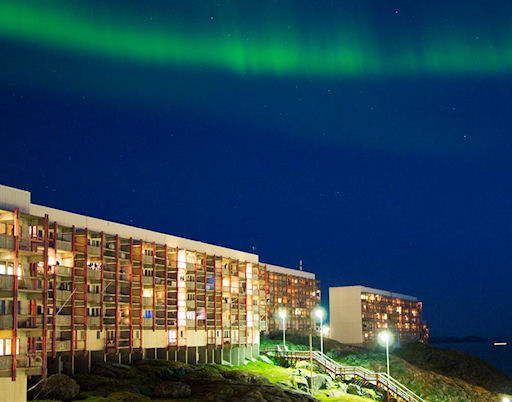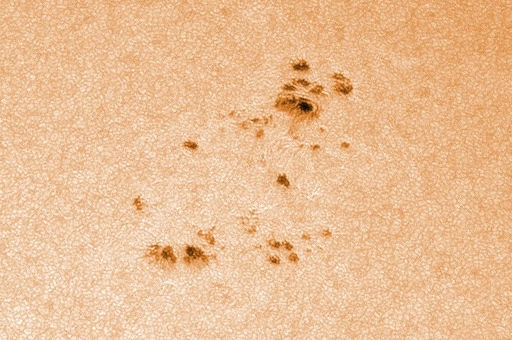AURORA ALERTS: Did you miss the Northern Lights? Next time get a wake-up call from Space Weather PHONE | | | SOLAR FLARE: Today at 1500 UT, magnetic fields above sunspot 1105 reconnected, producing a brief but explosive C1-class solar flare. NASA's Solar Dynamics Observatory recorded a bright flash of extreme UV radiation from the blast site: 0.7 MB movie. Sunspot 1105 is growing rapidly and seems poised to produce more flares in the hours ahead. GREEN LIGHTS OVER GREEN LAND: Earth is entering a solar wind stream, and this is causing geomagnetic activity around the poles. "We have seen our first auroras of the season," reports Rune Christiansen of Nuuk, the captital city of Greenland: 
It's been a while since Northern Lights were visible over Greenland. During summer, they are usually overwhelmed by the midnight sun. With the approach of northern autumn, however, Arctic nights are getting dark again and the auroras have returned. "I'm looking forward to a good season," says Christiansen. NOAA forecasters estimate a 40% chance of geomagnetic activity during the next 24 hours as the solar wind continues to buffet Earth's magnetic field. High-latitude sky watchers should remain alert for auroras. more images: from Sylvain Serre of Salluit, Nunavik, Quebec, Canada; from Jennith Peart of Baker Lake, Nunavut, Canada; from Lusine Akopyan of Thompson, Manitoba, Canada August 2010 Northern Lights Gallery
[previous Augusts: 2009, 2008, 2007, 2006, 2005, 2004, 2003] RASH SUNSPOT: It looks like the sun has developed rash. Sunspot group 1105 consists of more than 25 tiny spots scattered across an area some 40,000 km wide. Sascha Somodji sends this picture of the busy active region from his backyard observatory in Krefeld, Germany: 
Sunspot group 1105 stands in marked contrast to nearby sunspot 1101, which consists of a single dark core. (Click here to see the two side by side.) If sunspot 1101 looks boring, that's because it is. The sunspot's magnetic underpinnings resemble a simple dipole, and the spot is correspondingly quiet. Sunspot group 1105, on the other hand, is much more complicated with a profusion of opposite magnetic polarities popping up and bumping together. Magnetic reconnection is happening there almost non-stop, causing sunspot 1105 to crackle with B-class solar flares. It is, indeed, a "rash sunspot." more images: from Steve Rismiller of Milford, Ohio; from John Stetson of Portland, Maine; from Rolf Girssmann of Boostedt, Germany; from Cai-Uso Wohler of Bispingen, Germany; Potentially Hazardous Asteroids (PHAs) are space rocks larger than approximately 100m that can come closer to Earth than 0.05 AU. None of the known PHAs is on a collision course with our planet, although astronomers are finding new ones all the time. On September 6, 2010 there were 1144 potentially hazardous asteroids. Notes: LD means "Lunar Distance." 1 LD = 384,401 km, the distance between Earth and the Moon. 1 LD also equals 0.00256 AU. MAG is the visual magnitude of the asteroid on the date of closest approach. | | The official U.S. government space weather bureau | | | The first place to look for information about sundogs, pillars, rainbows and related phenomena. | | | Researchers call it a "Hubble for the sun." SDO is the most advanced solar observatory ever. | | | 3D views of the sun from NASA's Solar and Terrestrial Relations Observatory | | | Realtime and archival site_images of the Sun from SOHO. | | | from the NOAA Space Environment Center | | | from the National Solar Data Analysis Center | | 
